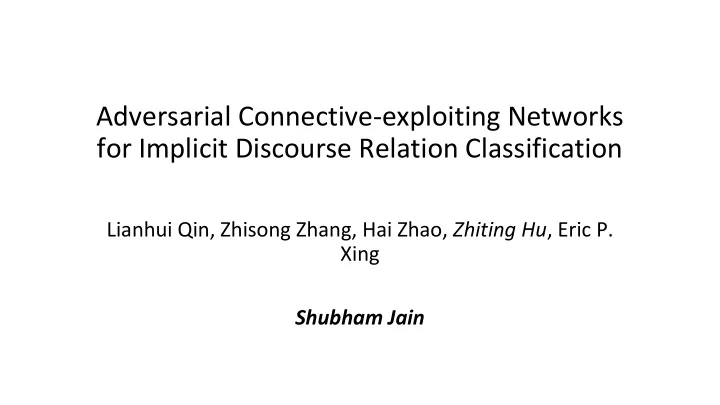

Adversarial Connective-exploiting Networks for Implicit Discourse Relation Classification Lianhui Qin, Zhisong Zhang, Hai Zhao, Zhiting Hu , Eric P. Xing Shubham Jain
Discourse Relations • Connect linguistic units (like sentences) semantically • Types: • Explicit: I like the food, but I am full. (Relation: Comparison) Use Connectives • Implicit: Never mind. You already know the answer. Connectives can be inferred 2
Implicit discourse relation Units : Never mind. You already know the answer. Connective: Never mind. Because you already know the answer. Sentence 1 : Never mind. Sentence 2 : You already know the answer. [ Implicit connective ]: Because [ Discourse relation ]: Cause 3
Discourse relation Classification • Connectives are very important cues • Explicit discourse relation : > 85% • Implicit discourse relation : < 50% (with end to end neural nets !!!) 4
The Idea • Human annotators adds the connectives to the dataset to find the relation • Example from Penn Discourse Treebank (PDTB) benchmark Never mind. You already know the answer. • Add the implicit connective Never mind. because You already know the answer. • Determine the relation 5
Idea • Use the annotated implicit connectives in the training data Implicit feature Relation: Cause Imitates the connective-augmented feature to improve discriminability Relation: Cause Highly-discriminative connective-augmented feature for classification 6
Feature imitation • Due to the connective cue, there is a huge gap in the features • Failed with using things like L2 distance reduction • It was necessary to use adaptive scheme to ensure discriminability : Adversarial networks 7
Adversarial Networks • Proposed by Goodfellow et al., 2014 • Idea : Say we want to generate images from a vector. • Generator : generate similar to a “correct values” to fool the discriminator • Discriminator : discriminate between the thing generated by the generator and the actual “correct values” 8
The model ● i-CNN wants to mimic a-CNN and both wants to maximize the classification accuracy from C ● Discriminator wants to discriminates between H I and H A 9
Network training Repeat : • Train i-CNN and C to maximize classification accuracy and fool D • Train a-CNN to maximize classification accuracy • Train D to distinguish between the two features Note : a-CNN is trained with C fixed as it is strong enough 10
Network details: CNNs • i-CNN • Word - Embedding layers, Convolutions and max-pooling • a-CNN • Word - Embedding layers, Convolutions • Average k-max pooling • Average of the top k values • Forces to “attend” the contextual features from the sentences i-CNN 11
Network details: Discriminator • Discriminator, D: • Multi fully connected layers (FCs) • Additional stacked gate to help in gradient propagation [Qin et al., 2016] • Classifier, C: • Fully connected layer followed by softmax Discriminator 12
Experiments • PDTB benchmark dataset • Sentence pairs, relation labels, implicit connectives • Multi-class classification task • 11 relation classes • Two slightly different settings as in previous work • One-vs-all classification tasks • 4 Relation classes: Comparison, Contingency, Expansion, Temporal 13
Multi-class classification task • Accuracy (%) on two settings 14
One-vs-all classification tasks • Comparisons of F1 scores (%) for binary classifications 15
Feature visualization • i -CNN (blue) and a -CNN (orange) feature vectors • (a): without adversarial mechanism • (b)-(c): features as training proceeds in the proposed framework 16
Conclusions • Connectives are very important cues • Use the additional data during training to propose a new feature learning • Proposed adversarial networks for feature learning with adaptive distance 17
Discussions • Generalization • Can be used in task in which we can use additional data during training time to learn better 18
Thanks 19
Recommend
More recommend